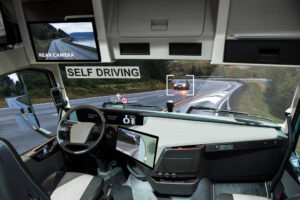Legal Alert from MG+M The Law Firm

Autonomous vehicle technologies, including full self-driving automobiles as well as simpler driver assist systems, are becoming more prevalent across the country. Most, if not all, new passenger cars come equipped with at least some form of autonomous technology including automatic cruise control, lane departure controls, and anti-collision warning systems. Specific to the trucking industry, there are significant and exciting autonomous systems being explored, such as Locomation’s (@LocomationAI) convoy system, which involves two trucks with two human drivers working in tandem with each other. Only one of the human drivers actively operates his or her truck at a given time, while the trailing truck operates fully autonomously in sync with the lead truck. This system allows the driver of the trailing truck to be “off-duty” and rest, thus theoretically, maximizing efficiency and lowering delivery times.
This and other autonomous vehicle technology will become common place over the next several years and certainly next several decades. So that begs the question, who is liable when a truck operating either fully autonomously or semi-autonomously causes an accident? The answer is not an easy one, and relevant case law is scant on this issue. One significant accident that could have provided relevant legal precedent involved a semi-autonomous Uber striking and killing a pedestrian in March 2018. However, Uber quickly settled with the decedent’s daughter thereby avoiding a civil lawsuit. However, the decedent’s family filed a civil lawsuit against the state of Arizona and the City of Tempe, and criminal charges were brought against the human “back-up” driver for negligent homicide. Both of those cases remain pending.
Typically, in civil lawsuits involving trucking accidents, the human driver is often named as a defendant facing allegations of individual negligence. But what happens when there is no human driver, or the human driver is only considered as a “back-up” to an autonomous system? In those instances, it is likely that in addition to typical claims against the human driver and the truck owner/company, plaintiffs will look to the developers, manufacturers, and providers of the autonomous software. A human truck driver facing a claim of negligence is judged by the courts on a “reasonable person” standard. Clearly, that standard cannot apply to an autonomous driving system. It flows rationally then, that products liability law may ultimately govern these types of lawsuits as plaintiffs will assert manufacturing defects and design defects of both the vehicle and the autonomous software.
Although plaintiffs may turn to the manufacturer of the autonomous driving system, the human “back-up” driver and the trucking company who chose to utilize an autonomous driving system may still be liable. Accordingly, it is imperative that corporations fully understand the potential legal implications prior to employing autonomous driving systems in their fleet. Additionally, as this technology develops, safety and training programs will become even more critical.
